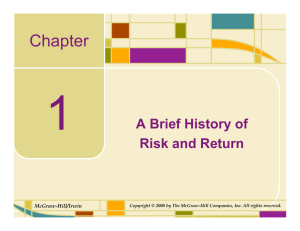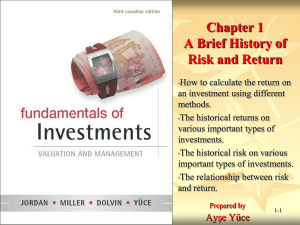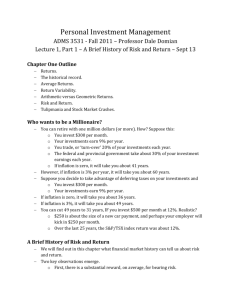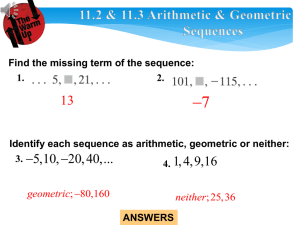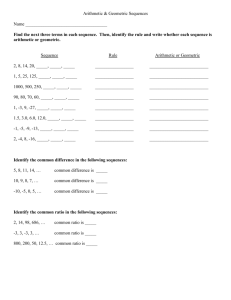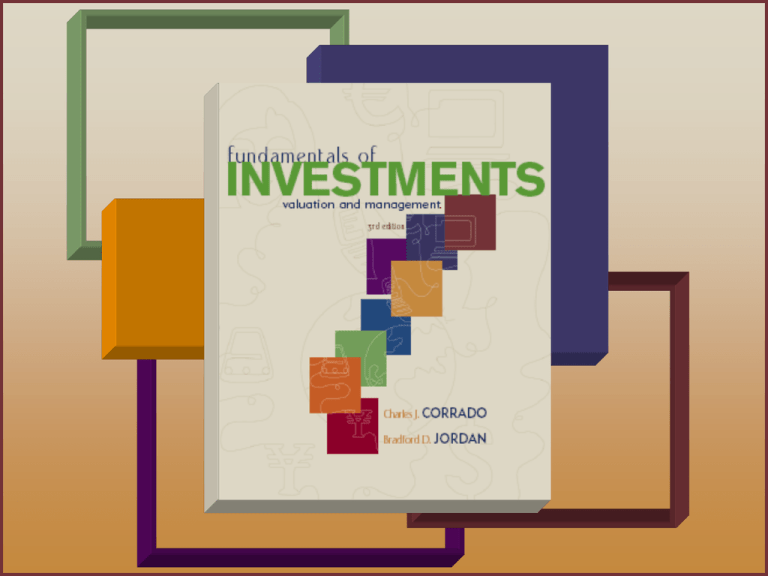
1-1
1
A Brief History of Risk & Return
McGraw-Hill/Irwin
Copyright © 2005 by The McGraw-Hill Companies, Inc. All rights reserved.
Example I: Who Wants To Be A Millionaire?
• You can retire with One Million Dollars (or more).
• How? Suppose this:
–
–
–
–
You invest $300 per month.
Your investments earn 9% per year.
You trade, or "turn-over" 20% of your investments each year.
The federal and state government take about 30% of your
investment earnings each year.
• If inflation is zero, it will take you about 41 years.
• However, if inflation is 3% per year, it will take you about 60
years. Hmm.
1-3
Example II: Who Wants To Be A Millionaire?
• Suppose you decide to take advantage of deferring taxes on your
investments and
– You invest $300 per month.
– Your investments earn 9% per year.
• If inflation is zero, it will take you about 36 years.
• If inflation is 3%, it will take you about 49 years.
– You can cut 49 years to 31 years, IF you invest $500 per month at
12%. Realistic?
• $250 is about the size of a new car payment, and perhaps your
employer will kick in $250 per month
• Over the last 77 years, the S&P 500 Index return was about 12%
Source: cgi.money.cnn.com/tools/millionaire/millionaire.html
1-4
A Brief History of Risk and Return
• Our goal in this chapter is to see what financial market
history can tell us about risk and return.
• Two key observations emerge.
– First, there is a substantial reward, on average, for bearing
risk.
– Second, greater risks accompany greater returns.
1-5
Dollar Returns
• Total dollar return is the return on an investment measured in
dollars, accounting for all interim cash flows and capital gains or
losses.
• Example:
Total Dollar Return on a Stock Dividend Income
Capital Gain (or Loss)
1-6
Percent Returns
• Total percent return is the return on an investment measured as a
percentage of the original investment. The total percent return is the
return for each dollar invested.
• Example, you buy a share of stock:
Percent Return on a Stock
Dividend Income Capital Gain (or Loss)
Beginning Stock Price
or
Total Dollar Return on a Stock
Percent Return
Beginning Stock Price (i.e., Beginning Investment )
1-7
Example: Calculating Total Dollar
and Total Percent Returns
•
•
•
Suppose you invested $1,000 in a stock with a share price of $25.
After one year, the stock price per share is $35.
Also, for each share, you received a $2 dividend.
•
What was your total dollar return?
–
–
–
–
•
$1,000 / $25 = 40 shares
Capital gain: 40 shares times $10 = $400
Dividends: 40 shares times $2 = $80
Total Dollar Return is $400 + $80 = $480
What was your total percent return?
– Dividend yield = $2 / $25 = 8%
– Capital gain yield = ($35 – $25) / $25 = 40%
– Total percentage return = 8% + 40% = 48%
Note that $480
divided by
$1000 is 48%.
1-8
A $1 Investment in Different Portfolios, 1926—2002.
1-9
1-10
The Historical Record: A Closer Look, I.
1-11
The Historical Record: A Closer Look, II.
1-12
The Historical Record: A Closer Look, III.
1-13
The Historical Record: A Closer Look, IV.
1-14
The Historical Record: A Closer Look, V.
1-15
Historical Average Returns
•
A useful number to help us summarize historical financial data is the
simple, or arithmetic average.
•
Using the data in Table 1.1, if you add up the returns for largecompany stocks from 1926 through 2002, you get 939.4 percent.
•
Because there are 77 returns, the average return is about 12.2%.
How do you use this number?
•
If you are making a guess about the size of the return for a year
selected at random, your best guess is 12.2%.
•
The formula for the historical average return is:
n
Historical Average Return
yearly return
i1
n
1-16
Average Annual Returns for Five Portfolios
1-17
Average Returns: The First Lesson
• Risk-free rate: The rate of return on a riskless, i.e., certain
investment.
• Risk premium: The extra return on a risky asset over the riskfree rate; i.e., the reward for bearing risk.
• The First Lesson: There is a reward, on average, for bearing
risk.
• By looking at Table 1.3, we can see the risk premium earned by
large-company stocks was 8.4%!
1-18
Average Annual Risk Premiums
for Five Portfolios
1-19
Why Does a Risk Premium Exist?
• Modern investment theory centers on this question.
• Therefore, we will examine this question many times in the
chapters ahead.
• However, we can examine part of this question by looking at the
dispersion, or spread, of historical returns.
• We use two statistical concepts to study this dispersion, or
variability: variance and standard deviation.
•
The Second Lesson: The greater the potential reward, the greater
the risk.
1-20
Return Variability: The Statistical Tools
• The formula for return variance is ("n" is the number of returns):
R R
N
VAR(R) σ
2
i1
2
i
N 1
• Sometimes, it is useful to use the standard deviation, which is
related to variance like this:
SD(R) σ VAR(R)
1-21
Return Variability Review and Concepts
• Variance is a common measure of return dispersion.
Sometimes, return dispersion is also call variability.
• Standard deviation is the square root of the variance.
– Sometimes the square root is called volatility.
– Standard Deviation is handy because it is in the same "units" as the
average.
• Normal distribution: A symmetric, bell-shaped frequency
distribution that can be described with only an average and a
standard deviation.
• Does a normal distribution describe asset returns?
1-22
Frequency Distribution of Returns on
Common Stocks, 1926—2002
1-23
Example: Calculating Historical Variance
and Standard Deviation
•
•
Let’s use data from Table 1.1 for large-company stocks, from 1926 to
1930.
The spreadsheet below shows us how to calculate the average, the
variance, and the standard deviation (the long way…).
(1)
(2)
Year
1926
1927
1928
1929
1930
Sum:
Return
13.75
35.70
45.08
-8.80
-25.13
60.60
Average:
12.12
(3)
Average
Return:
12.12
12.12
12.12
12.12
12.12
(4)
Difference:
(2) - (3)
1.63
23.58
32.96
-20.92
-37.25
Sum:
(5)
Squared:
(4) x (4)
2.66
556.02
1086.36
437.65
1387.56
3470.24
Variance:
867.56
Standard Deviation:
29.45
1-24
Historical Returns, Standard Deviations, and
Frequency Distributions: 1926—2002
1-25
The Normal Distribution and
Large Company Stock Returns
1-26
Return Variability: “Non-Normal” Days
Top 12 One-Day Percentage Declines in the
Dow Jones Industrial Average
Source: Dow Jones
December 12, 1914
-24.4%
August 12, 1932
-8.4%
October 19, 1987
-22.6
March 14, 1907
-8.3
October 28, 1929
-12.8
October 26, 1987
-8.0
October 29, 1929
-11.7
July 21, 1933
-7.8
November 6, 1929
-9.9
October 18, 1937
-7.7
December 18, 1899
-8.7
February 1, 1917
-7.2
1-27
Arithmetic Averages versus
Geometric Averages
• The arithmetic average return answers the question: “What was
your return in an average year over a particular period?”
• The geometric average return answers the question: “What was
your average compound return per year over a particular
period?”
• When should you use the arithmetic average and when should
you use the geometric average?
• First, we need to learn how to calculate a geometric average.
1-28
Example: Calculating a
Geometric Average Return
•
•
Again, let’s use the data from Table 1.1 for large-company stocks, from
1926 to 1930.
The spreadsheet below shows us how to calculate the geometric
average return.
Year
1926
1927
1928
1929
1930
Percent
Return
13.75
35.70
45.08
-8.80
-25.13
One Plus
Return
1.1375
1.3570
1.4508
0.9120
0.7487
Compounded
Return:
1.1375
1.5436
2.2394
2.0424
1.5291
(1.5291)^(1/5):
1.0887
Geometric Average Return:
8.87%
1-29
Arithmetic Averages versus
Geometric Averages
• The arithmetic average tells you what you earned in a typical
year.
• The geometric average tells you what you actually earned per
year on average, compounded annually.
• When we talk about average returns, we generally are talking
about arithmetic average returns.
• For the purpose of forecasting future returns:
– The arithmetic average is probably "too high" for long forecasts.
– The geometric average is probably "too low" for short forecasts.
1-30
Geometric versus Arithmetic Averages
1-31
Risk and Return
• The risk-free rate represents compensation for just waiting.
• Therefore, this is often called the time value of money.
• First Lesson: If we are willing to bear risk, then we can expect to
earn a risk premium, at least on average.
• Second Lesson: Further, the more risk we are willing to bear, the
greater the expected risk premium.
1-32
Historical Risk and Return
1-33
A Look Ahead
• This text focuses exclusively on financial assets: stocks, bonds,
options, and futures.
• You will learn how to value different assets and make informed,
intelligent decisions about the associated risks.
• You will also learn about different trading mechanisms, and the
way that different markets function.
1-34
Useful Internet Sites
•
•
•
•
•
•
cgi.money.cnn.com/tools/millionaire/millionaire.html (millionaire link)
finance.yahoo.com (reference for a terrific financial web site)
www.globalfindata.com (reference for free historical financial market
data)
www.nyse.com (reference for the New York Stock Exchange)
www.sec.gov (reference for the Securities and Exchange Commission)
www.robertniles.com/stats (reference for easy to read statistics review)
1-35
Chapter Review, I.
• Returns
– Dollar Returns
– Percentage Returns
• The Historical Record
– A First Look
– A Longer Range Look
– A Closer Look
• Average Returns: The First Lesson
– Calculating Average Returns
– Average Returns: The Historical Record
– Risk Premiums
1-36
Chapter Review, II.
• Return Variability: The Second Lesson
–
–
–
–
–
Frequency Distributions and Variability
The Historical Variance and Standard Deviation
The Historical Record
Normal Distribution
The Second Lesson
• Arithmetic Returns versus Geometric Returns
• The Risk-Return Trade-Off
1-37
Assignment Number 1
• First Group Assignment
– Forecast S&P 500 Index for
•
•
•
•
End of Year, 2005
End of Year, 2006
End of Year, 2010
End of Year, 2015
– Point estimates and short explanation of methodology
• Historical Perspective
– Record High of S&P 500
• 1527.46 on March 24, 2000
– Yesterday’s Close
• 1215.66 on September 28, 2005
• Average Return in the 00s
– Negative 4.5%
1-38




